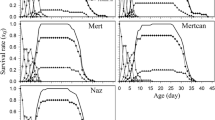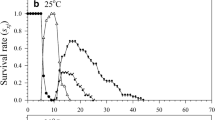Abstract
Thermal requirements per developmental stage, offspring production, and percent survival of three isolates of the green peach aphid,Myzus persicae (Sulz.), were determined over a range of constant temperatures from 12.4°–29.4°C. Isolates were collected from Pennsylvania, Maine, and Washington State potato producing regions. Offspring produced, survival, and thermal requirements were not different for all three isolates. Offspring production increased from 12.4°–15.6°C and then decreased as temperature increased. Percent survival averaged 78.2% except at 29.4°C where only 26.7% survived to reproduce. Thermal requirements, with 4°C as the lower developmental threshold, were 25.2, 27.1, 30.9, 30.7, 20.4, 74.2, 201.6 and 135.7 degree days, respectively, for instars 1–4, prereproductive adults, reproductive adults, longevity, and generation time. Data were used as the basis for a computer forecast system to predict aphid population development in potato fields.
Resumen
Los requerimientos termales por estadio de desarrollo, la producción de descendientes y el porcentaje de supervivencia de tres aislamientos del áfidoMyzus persicae (Sulz.), fueron determinados para un rango de temperaturas constantes desde 12.4° hasta 29.4°C.Los aislamientos fueron colectados en las regiones productoras de papa de los estados de Pennsylvania, Maine y Washington. Los descendientes producidos, la supervivencia y los requerimientos termales fueron iguales para los tres aislamientos. La producción de descendientes aumentó de 12.4° a 15.6°C y luego disminuyó conforme se aumentó la temperatura. El porcentaje de supervivencia promedió 78.2% excepto a 29.4°C donde solamente sobrevivieron 26.7%. Los requerimientos termales con 4°C como la temperatura más baja para desarrollo fueron 25.2, 27.1, 30.9, 30.7, 20.4, 74.2, 201.6 and 135.7 grados por día para estadios de 1–4, adultos prereproductivos, adultos reproductivos, longevidad y tiempo de generación, respectivamente. Los datos fueron usados como la base para un sistema computarizado de predicción para predecir el desarrollo de la población de áfidos en cultivos de papa.
Similar content being viewed by others
Literature Cited
Barbagallo, S., R. Inserra, and G.N. Foster. 1972. Population dynamicsof Myzus persicae (Sulzer) on potato in Sicily. Entomologica 8: 21–33.
Barlow, C.A. 1962. The influence of temperature on the growth of experimental populations ofMyzus persicae (Sulzer) andMacrosiphum euphoribiae (Thomas). Can J Zool 40: 145–56.
Barr, A.J., J.H. Goodnight, J.P. Sall, and J.T. Helwig. 1976. A users guide to SAS 76. Sparks Press, Raleigh, NC 329 pp.
Blackman, R.O. 1971. Variation in the photoperiodic response within natural populations ofMyzus persicae (Sulz.). Bull Entomol Res 60: 533–46.
Broadbent, L. 1949. The grouping and overwinteringof Myzus persicae (Sulz.)on Prunus species. Ann Appl Biol 36: 334–40.
Coon, B.F. 1959. Aphid populations on oats grown in various nutrient solutions. J Econ Entomol 52: 624–6.
Eastop, V.F. 1973. Biotypes of aphids.In Perspectives in Aphid Biology (Ed. A.D. Lowe), pp. 40–47. Bull Entomol Soc, NZ, 2.
Horsfall, J.L. 1924. Life History Studiesof Myzus persicae (Sulzer). Pa Agric Exp Stn Bull 185: 5–16.
MacGillivray, M.E. and G.B. Anderson. 1958. Development of four species of aphids on potato. Can Entomol 90: 148–55.
Mackauer, M. and M.J. Way. 1976.Myzus persicae (Sulz.) an aphid of world importance.In: IBP Report on Biological Control Programs, No. 9. pp. 401.
Montgomery, D.C. 1976. Design and analysis of experiments. John Wiley and Sons, New York, NY. 418 pp.
Neter, J. and W. Wasserman. 1974. Applied linear statistical models. R.D. Irwin, Inc., Homewood, IL, USA. 842 p.
Stinner, R.E., A.P. Gutierrez, and G.D. Butler. 1974. An algorithm for temperature-dependent growth rate stimulation. Can Entomol 106: 519–24.
Walton, R.R. 1954. Seasonal fluctuations of the green peach and turnip aphids on commercial green crops in Oklahoma. J Econ Entomol 47: 775–80.
Whalon, M.E. and Z. Smilowitz. 1977. Determination of consultant temperature developmental thresholds forMyzus persicae (Sulz.). NY Entomol Soc 85: 206.
Whalon, M.E. and Z. Smilowitz. 1979. Temperature-dependent model for predicting field populations of green peach aphid,Myzus persicae (Sulz.). Can Entomol (In press).
Whalon, M.E. and Z. Smilowitz. 1979. GPA-CAST, a computer forecasting system for predicting populations and implementing control of the green peach aphid on potatoes. Environ Entomol (In press).
Additional information
Pesticide Research Laboratory and Graduate Study Center and Department of Entomology, The Pennsylvania State University, University Park, Pennsylvania 16802.
Authorized for publication on July 14, 1978 as paper no. 5561 in the Journal Series of the Pennsylvania Agricultural Experiment Station.
Rights and permissions
About this article
Cite this article
Whalon, M.E., Smilowitz, Z. The interaction of temperature and biotype on development of the green peach aphid,Myzus persicae (Sulz.). American Potato Journal 56, 591–596 (1979). https://doi.org/10.1007/BF02853990
Received:
Issue Date:
DOI: https://doi.org/10.1007/BF02853990




